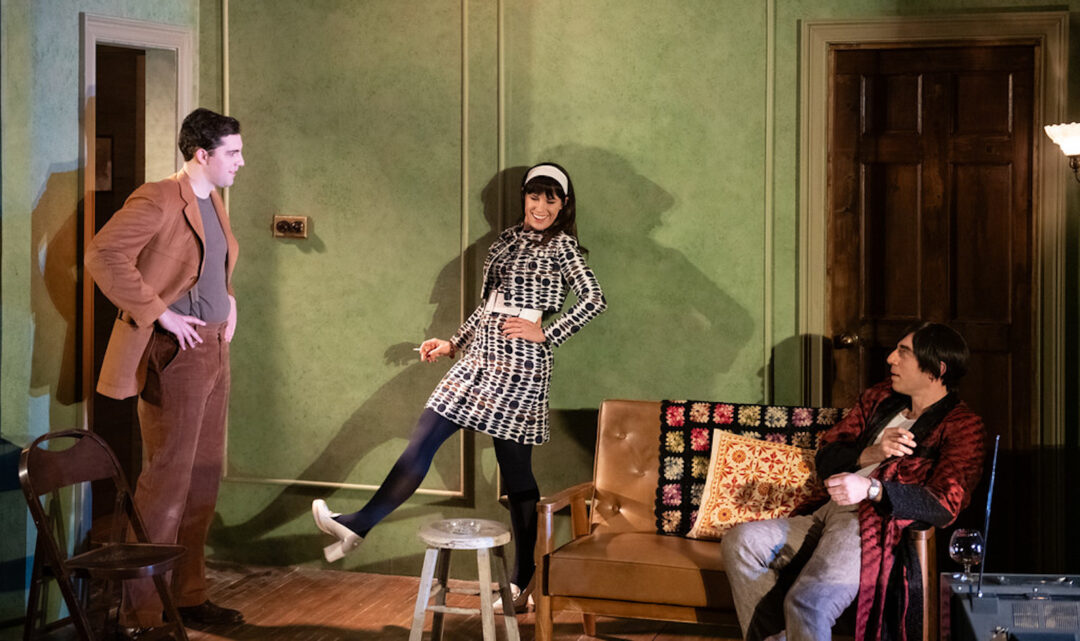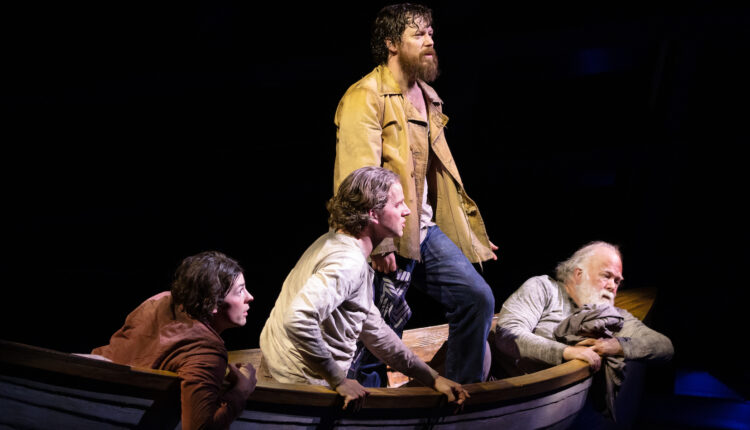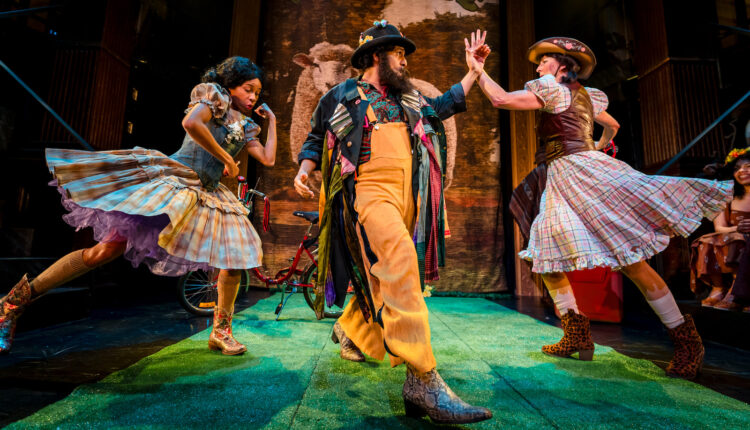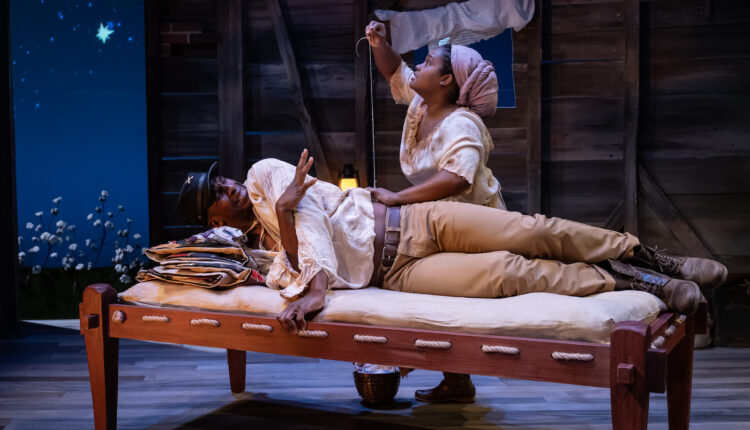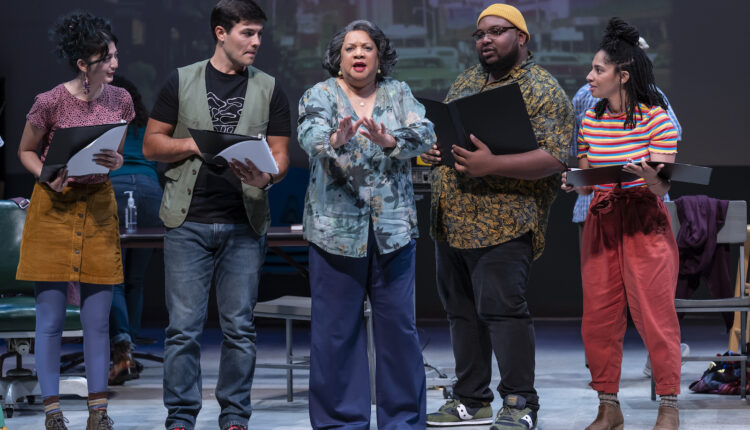By Dillon Lewis
This article was originally published in DCTRENDING here.
If Bravo had been spinning off franchises in the 12th century BC, one can only imagine that “Phone rings, door chimes, in comes… Company?” That refrain is one of Stephen Sondheim’s greatest earworms (second only perhaps to “Bobby, Bobby baby, Bobby bubi, Robby,” etc. in the same song). And, in the touring production of Marianne Elliott’s inventive reimagining of the beloved musical, playing at the Kennedy Center through March 31, it presents more like a cautious question than a confident declaration.
Written by George Furth, with music and lyrics by Sondheim, Company is a musical meditation on matrimonial commitment. Premiering in 1970, Company originally centered on bachelor Bobby as he navigated romances with three wildly different women and friendships with five very quirky married couples. Directed by legendary impresario Harold Prince on its initial outing, Company was among the first “concept musicals,” dissecting a topic without much concern for a plot driven by linear narrative. Responsible for such standards as “Being Alive” and “The Ladies Who Lunch,” it is now widely regarded as a masterpiece in the American musical canon.
This production, helmed by British director Elliott, boldly reimagines Bobbie (Britney Coleman) as a chic 35-year-old career woman navigating the modern world. Having premiered in London’s West End in 2018, Elliott’s adaptation initiated a transfer to New York, preparing for a scheduled opening just days after the onset of the COVID-19 pandemic shut down the world and, with it, Broadway. When it finally opened in December 2021, audiences were thrilled to be returning to theaters after the long pause and still reeling from Sondheim’s death the month prior. To take in such a daring reinvention of the show that had marked the start of Sondheim’s most productive working period was to sit in celebration of a man who continually reinvented the form. The experience was nothing short of catharsis. This critic gleefully returned a second time.
But the touring production, while maintaining the bones of Elliott’s London and New York mountings, has lost some muscle. One can’t shake the pervasive “hand-me-down” feeling as the tightness of Elliott’s vision. Resisting previous requests to reconceptualize Bobby as a gay man or woman, Sondheim finally relented when Elliott approached him with her concept (which includes other swaps beyond Bobbie, including the introduction of a gay couple). Unfortunately, the touring production makes a weak case that Company can withstand such reimagining and poorly stewards both the original material and Elliott’s concept.
The exception is in the song “Tick Tock,” which has been brilliantly reimagined by Elliott and choreographer Liam Steel and makes the sturdiest assertion that a gender-swapped Company can pack a comparable punch. The staging is so tight, especially compared with the rest of the production, that it gives the impression of being the precipitating reason for doing the show in the first place. From the first moments of the production, we hear a ticking clock (replacing the show’s more traditional busy signal), working double duty as both a reminder of Bobbie’s birthday and, by the time “Tick Tock” rolls around, a pervasive symbol of her “biological clock”. As she imagines the rest of her life with each of the three men she is dating, she generally winds up in the same spot at the end of the respective romances: by the completion of the number, all of the pseudo-Bobbies who mime the life ahead stare at Coleman’s Bobbie, as if to ask, “Are we doing this or not?”
Sondheim’s work is known for its specificity, reflecting one of his own oft-espoused creative mantras: God is in the details. In retrofitting George Furth’s airtight book to accommodate both the gender shift and resetting into a modern era, Elliott has inadvertently accentuated its aging wrinkles. While they may have gone less noticed in the Broadway production, they land with a thud on the Kennedy Center stage. For the most part, the cast attempts to conceal such textual blemishes by turning the characters into caricatures. Erring on the side of farce, they play it for laughs, mostly to the opposite effect. And even with large gestures and uncomfortable pauses for anticipated audience reaction, the performances get lost in the Kennedy Center’s cavernous Opera House (which, incidentally, perfectly matches Bobby’s scarlet garments by Bunny Christie, who designed both the sets and costumes).
Even so, a handful of excellent performances can break through to delightful results. As Andy, a hunky, but air-headed flight attendant with whom Bobbie enjoys a roll in the hay, Jacob Dickey is sublime. They rely almost entirely on their instinctive comic timing, avoiding any bouts of in-flight turbulence. As Jamie, Matt Rodin easily maneuvers through one of musical theater’s most notoriously difficult patter songs, “Getting Married Today,” balancing skillful pacing with convincing acting. Portraying the erratic gay groom suddenly stricken with cold feet, he is heartbreaking in exclaiming, “Just because we can doesn’t mean we should.” And doubling as Susan (delightful) and Jamie’s wedding officiant (hilarious), Marina Kondo brightens the stage whenever she appears.
Unfortunately, Bobbie so often fades into the background of this production that when Britney Coleman steps forward to sing several solo turns, they feel less like indicators of emotional transformation-in-progress and more like reminders that, hey, it’s actually Bobbie’s show. Coleman acts valiantly through the songs in particular, and when she sings “Someone is Waiting” and “Marry Me a Little,” it is evident that she has dissected every note and lyric of the song to achieve full understanding. She has clearly done the hard work of a consummate professional, but against so many unwieldy, larger-than-life ensemble performances, she hardly stands a chance. But in “Barcelona,” a quiet post-coital cat-and-mouse duet, Coleman and Dickey together deliver one of the evening’s most memorable moments.
Christie’s set hinges on the use of large cubes that evoke the claustrophobia of tiny, whitewash-and-chrome New York apartments. They move in near-constant rotation, reconfiguring into different, distinct abodes. She has hidden 35’s throughout the set like Easter eggs, appearing in artworks and transoms, underscoring the sense that Bobbie’s birthday (and all that it means for her opportunities to start a family) is always hanging overhead. Christie’s cubes are accented by Neil Austin’s neon-tinged lighting design which, even while colorful, amplifies the sense of sterility in Christie’s set. Keith Caggiano’s sound design proved challenging in the Opera House, where balance issues left some performers completely unamplified and impossible to hear over the orchestra.
In “Another Hundred People,” Sondheim’s biting send-up of the endless inflows and outflows of people (and romantic partners) to and from New York City, the cast dutifully wheels out large cutouts of the letters in the show’s title. They rearrange them several times, only twice forming coherent words (or acronyms, in any case): “COMPANY” and “NYC”. The remainder of the rearrangements are mismatched jumbles, leaving audiences to make sense of the staging while the exquisite score plays behind, out of focus. For this Company, it’s hard to imagine a better metaphor.



